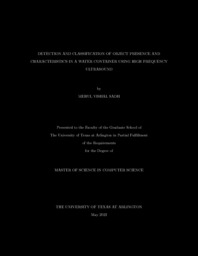
ATTENTION: The works hosted here are being migrated to a new repository that will consolidate resources, improve discoverability, and better show UTA's research impact on the global community. We will update authors as the migration progresses. Please see MavMatrix for more information.
Show simple item record
| dc.contributor.advisor | Huber, Manfred | |
| dc.creator | Sadh, Mehul Vishal | |
| dc.date.accessioned | 2022-06-28T15:12:39Z | |
| dc.date.available | 2022-06-28T15:12:39Z | |
| dc.date.created | 2022-05 | |
| dc.date.issued | 2022-05-17 | |
| dc.date.submitted | May 2022 | |
| dc.identifier.uri | http://hdl.handle.net/10106/30417 | |
| dc.description.abstract | Detection and characterization of soluble, diffuse, and solid objects and their characteristics in water has important implications in various applications, including water quality assessment and incontinence monitoring for health applications. In particular in the latter task, it is essential to be able to non-intrusively detect the appearance, presence, and consistency of materials in the water without the need for special purpose instruments or a special purpose setting. Rather, it would be important that sensing could be performed int he context of existing toilet systems. To achieve this, this work investigates the potential use of high frequency sonar sensors retrofitted to an existing, water-filled container to detect and characterize events where materials are added to the water, and to classify characteristics of the materials in terms of solubility, granularity, and density of the added materials.
A goal of the sensor choice here it to be non-intrusive, that they can be retrofitted to an existing container, and that they do not require significant cleaning and maintenance. To address this, this work investigates the use of high frequency ultrasound as a sensing technology. The fact that humans cannot perceive sound waves above 20000 Hz, opens a way to use these waves for a wide variety of problems. Ultrasonic waves have been widely used in various applications such as nondestructive testing of materials, range finding (SONAR), sonography for medical imaging, fluid flow measurement and non-contact sensing. However, for most of these applications specialized devices and test settings have to be designed. Here we aim at using standard transducers attached to existing vessel to obtain the desired information by measuring the changes in absorption and diffraction characteristics as the ultrasonic waves pass through the introduced materials.
Understanding these wave patterns after passing them through materials can here provide a way to understanding unique features of the objects and materials introduced into the water. To allow for the detection and classification of important material properties, frequency features are here extracted using Fourier Transforms and then used to train a model to detect the introduction of objects into the water and to classify the object characteristics while underwater. The goal here is to investigate the extent at which various kinds of objects with different properties can be classified on the basis of the wave patterns that the objects create when submerged underwater, and to build a prototype system that could be retrofitted to existing containers to perform such measurements. | |
| dc.format.mimetype | application/pdf | |
| dc.language.iso | en_US | |
| dc.subject | Ultrasonic waves | |
| dc.subject | High frequency waves | |
| dc.subject | Classification of materials | |
| dc.subject | Neural networks | |
| dc.subject | Signal processing | |
| dc.subject | Fourier transform | |
| dc.subject | Object presence detection | |
| dc.title | Detection and classification of object presence and characteristics in a water container using high frequency ultrasound | |
| dc.type | Thesis | |
| dc.degree.department | Computer Science and Engineering | |
| dc.degree.name | Master of Science in Computer Science | |
| dc.date.updated | 2022-06-28T15:12:39Z | |
| thesis.degree.department | Computer Science and Engineering | |
| thesis.degree.grantor | The University of Texas at Arlington | |
| thesis.degree.level | Masters | |
| thesis.degree.name | Master of Science in Computer Science | |
| dc.type.material | text | |
| dc.creator.orcid | 0000-0002-9031-952X | |
Files in this item
- Name:
- SADH-THESIS-2022.pdf
- Size:
- 1.781Mb
- Format:
- PDF
This item appears in the following Collection(s)
Show simple item record


